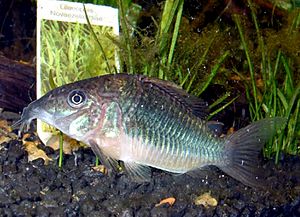Emerald catfish facts for kids
Quick facts for kids Emerald catfish |
|
|---|---|
 |
|
| Scientific classification | |
| Synonyms | |
|
The emerald catfish (Corydoras splendens) is a cool tropical freshwater fish. It belongs to a group of fish called Corydoradinae. This fish lives in rivers and streams in the Amazon Basin in South America. People used to call it Brochis splendens. This special fish even appeared on a stamp in Brazil!
Contents
About Its Name
This fish has had a few different names over the years! A scientist named François Louis de la Porte, comte de Castelnau first described it in 1855. He called it Callichthys splendens. For a while, it was also known as Brochis coeruleus.
Later, scientists realized these were actually the same fish. In 1970, two scientists, Njiseen and Isbrücker, officially combined them. The fish was then called Brochis splendens. But most fish in the Brochis group were later moved into the Corydoras group. So, its official name today is Corydoras splendens.
Where It Lives
The emerald catfish comes from the upper parts of the Amazon Basin. This includes rivers like the Ucayali River and Ambiyacu River. You can find it near Pucallpa and Iquitos. It lives in western Brazil, southeastern Colombia, eastern Ecuador, and eastern Peru.
What It Looks Like
This fish is really pretty! Its body can look metallic green, blue-green, or even bluish. This depends on how the light hits it. Its belly is usually yellowish. The fins near its chest, belly, and bottom are also yellowish. The fins on its back, tail, and the small adipose fin are a see-through brownish color.
Female emerald catfish are bigger and stronger than males. They also have a more pinkish belly, while males have a more yellowish one. You can tell this fish apart from other green or bronze corydoras catfish. It is usually larger, has a sturdier body, and a more pointed nose.
Its Home in Nature
The emerald catfish likes to live in slow-moving water. These places often have lots of plants along the banks. It prefers shallow, muddy waters. This fish can grow up to about 7.5 centimeters (3 inches) long.
It lives in a tropical climate. The water it likes has a pH between 5.8 and 8.0. The water hardness is 2 to 30 dGH. The temperature range is 22 to 28 degrees Celsius (72 to 82 degrees Fahrenheit). It eats worms, small crustaceans that live on the bottom, and insect larvae. It lays its eggs among thick plants. The adult fish do not guard their eggs.
In the Aquarium
The emerald catfish is a popular fish for freshwater aquariums. It is a peaceful fish and not hard to care for. You can keep it in the same conditions as most other Corydoras species.
They can be shy if kept alone. It is best to keep them in small groups of at least three fish. More is even better! The bottom of the tank should have soft, fine sand. This stops their sensitive whiskers (barbels) from getting hurt. The tank should also have lots of plants. Feeding them is easy, as they eat almost anything. But they especially love live worms. They do well in a community tank with other fish. They also do not pull up plants.
Reproduction
People have successfully bred emerald catfish in aquariums. To do this, fish are usually put into a special breeding tank. The best ratio is three males for every two females. All the fish should be well-fed with live foods.
The fish will lay eggs while sitting on the bottom of the tank. This is different from many similar fish that lay eggs while swimming. The female collects the eggs in her pelvic fin. Then, she sticks them one by one onto plants and other things in the tank. She will put eggs all over the tank. But she especially likes to put them on any floating plants. Most reports say the parents do not try to eat the eggs right away. The eggs hatch in about four days. The baby fish start swimming freely two days later.
See also
 In Spanish: Brochis splendens para niños
In Spanish: Brochis splendens para niños
- List of freshwater aquarium fish species
- Care information for the Emerald catfish at the Aquarium Wiki

